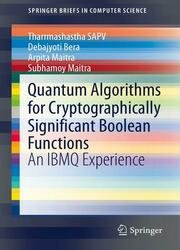 Название: Quantum Algorithms for Cryptographically Significant Boolean Functions: An IBMQ Experience
Название: Quantum Algorithms for Cryptographically Significant Boolean Functions: An IBMQ ExperienceАвтор: Tharrmashastha SAPV, Debajyoti Bera
Издательство: Springer
Серия: SpringerBriefs in Computer Science
Год: 2021
Страниц: 128
Язык: английский
Формат: pdf (true), epub
Размер: 33.2 MB
This book is a timely report of the state-of-the-art analytical techniques in the domain of quantum algorithms related to Boolean functions. It bridges the gap between recent developments in the area and the hands-on analysis of the spectral properties of Boolean functions from a cryptologic viewpoint. Topics covered in the book include Qubit, Deutsch–Jozsa and Walsh spectrum, Grover’s algorithm, Simon’s algorithm and autocorrelation spectrum. The book aims at encouraging readers to design and implement practical algorithms related to Boolean functions. Apart from combinatorial techniques, this book considers implementing related programs in a quantum computer. Researchers, practitioners and educators will find this book valuable.
If you are asking about quantum computation, the easiest way is to search the internet and learn the basics. On the other hand, if you have a basic idea of the quantum paradigm, as well as high-school level understanding of mathematics and programming, then the first thing you may like to do is to write a program that will run on a quantum computer. There are many such computing facilities available, and the most popular one is possibly the IBM Quantum platform. IBM Quantum provides a nice platform to write programs that run on a quantum computer (naturally with some limitations at this stage). Our first motivation in this book is that a person with knowledge of basic programming and high-school mathematics should be able to connect to the machine and then start writing a program as soon as possible. This is why this book starts with a simple explanation of a quantum computer and immediately dives into writing simple programs. The elementary building blocks of the quantum computing paradigm and how to write programs on such a platform are thus the motivations of the very first chapter.
Скачать Quantum Algorithms for Cryptographically Significant Boolean Functions: An IBMQ Experiences